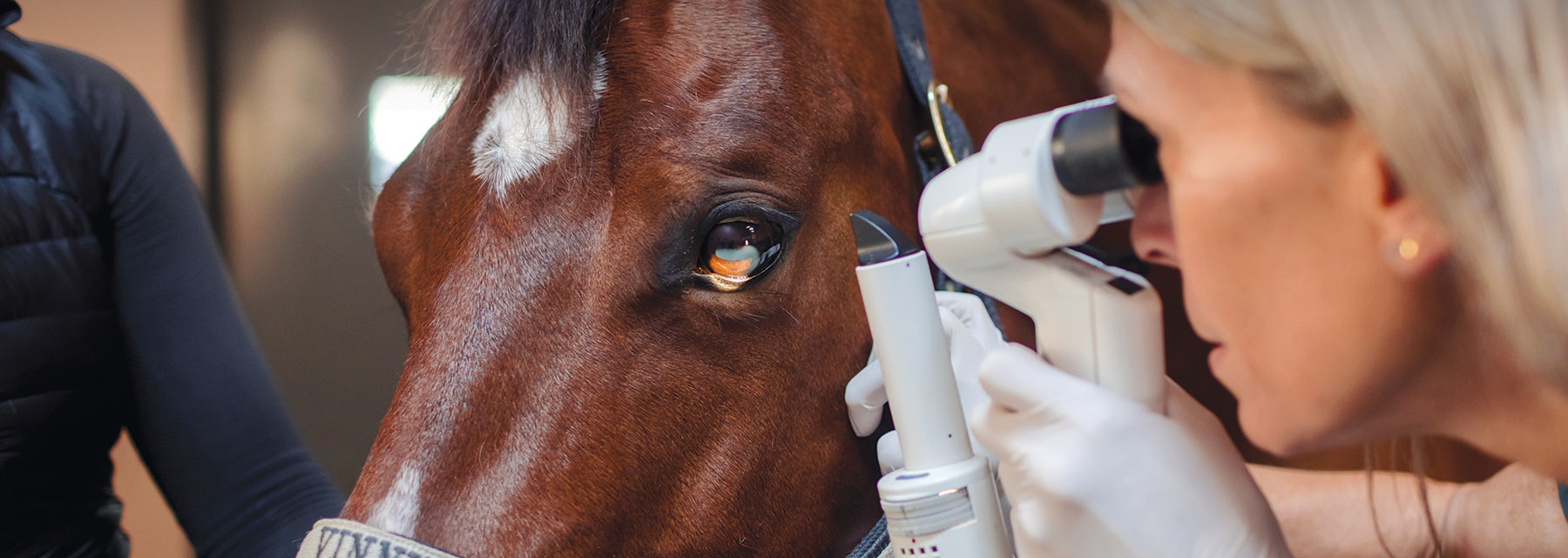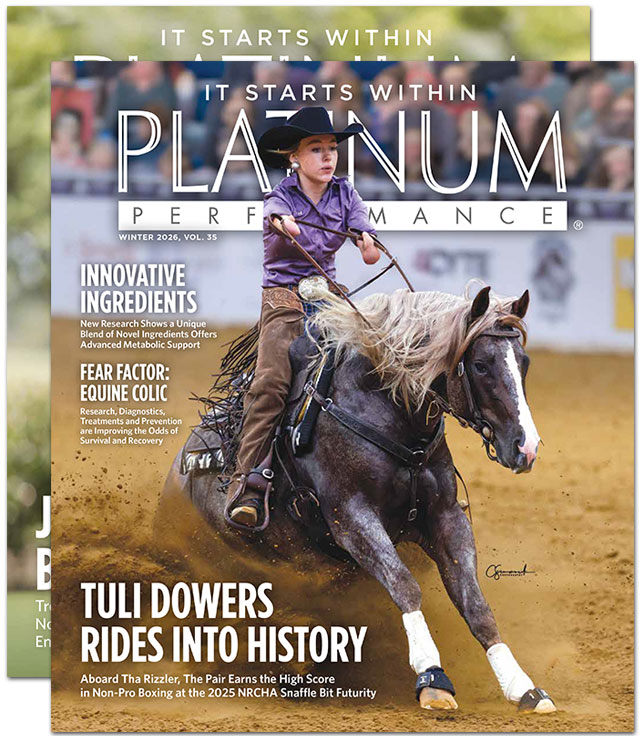Examining Equine Recurrent Uveitis and How This Historically Problematic Condition Affects Horses
Equine recurrent uveitis, commonly called “moon blindness” or periodic ophthalmia, affects a vast number of the equine population, and continues to be the focus of concentrated and ongoing research in veterinary ophthalmology. Although the disease has been documented since the 15th century, there is no cure. The cause of this immune-linked disease has not been completely elucidated and is likely multi-factorial, making it a huge and expensive (estimated yearly cost to the equine community of $140 million to $350 million) challenge for both horse owners and the veterinary community.
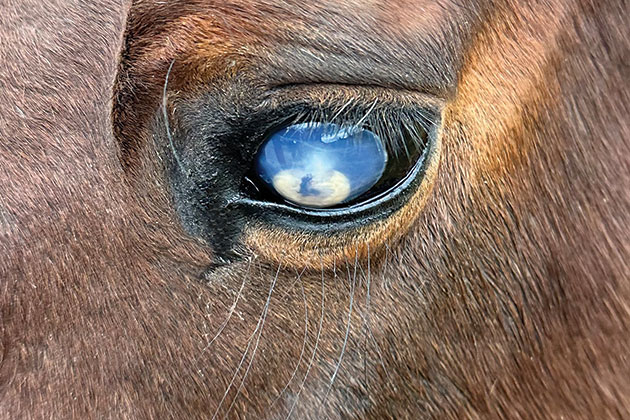

Did You Know?
“Moon blindness” was first used to describe this inflammatory eye condition in the 1600s when people thought that the moon’s phases correlated with repeated episodes of temporary blindness in their horses.
What is ERU?
Uveitis is inflammation of the eye’s middle layer, the uveal tract. This tissue can become inflamed for various reasons, including infections or trauma. In simple uveitis cases, the inflammation resolves completely once the underlying cause has resolved.
Equine recurrent uveitis is a more-challenging form of uveitis that does not resolve and periodically flares up. In this complex autoimmune disease, the body’s immune system attacks its inner eye tissue. It is most often characterized by recurring episodes of inflammation of the uveal tract. It can involve one or both eyes, and it is likely that both genetic and environmental factors influence most cases. ERU causes discoloration of the eye — resulting in a milky or cloudy appearance — and affected horses are very sensitive to sunlight. ERU can be very painful, and the removal of the affected eye can be required.
ERU can be divided into three subclinical syndromes: classic, insidious and posterior. The classic form is the most common and involves episodes of acutely painful, actively inflamed eye(s) separated by episodes of low-level inflammation or seemingly symptom-free periods. This episodic cycle often leads to vision loss or blindness. Insidious ERU does not have obvious episodes and is not outwardly painful. Horses will have chronic, subclinical ocular inflammation that causes gradual and cumulative deterioration of the eye tissues and structures. Posterior ERU, more common in Warmbloods and draft breeds, is characterized by inflammation of structures in the back (posterior) of the eye, including the vitreous, retina and choroid. The persistent inflammation, often with repeated episodes, causes cumulative damage that can result in scarring within the eye, glaucoma, cataracts, retinal degeneration, eye cancer and, ultimately, blindness. The chronic pain that often accompanies ERU can greatly alter a horse’s quality of life.
The Three Subclinical Syndromes of ERU — A Complex Autoimmune Disease
Equine recurrent uveitis is a more-challenging form of uveitis that does not resolve and periodically flares up. The body’s immune system attacks its inner eye tissue and can involve one or both eyes. It is likely that both genetic and environmental factors influence most cases. ERU causes discoloration of the eye — resulting in a milky or cloudy appearance.
1.
Classic
The classic form is the most common and involves episodes of acutely painful, actively inflamed eye(s) separated by episodes of low-level inflammation or seemingly symptom-free periods.
Often leads to vision loss or blindness.
2.
Insidious
Insidious ERU does not have obvious episodes and is not outwardly painful. Horses will have chronic, subclinical ocular inflammation.
Gradual and cumulative deterioration of the eye tissues and structures.
3.
Posterior
Characterized by persistent inflammation, often with repeated episodes, of structures in the back of the eye, including the vitreous, retina and choroid.
Cumulative damage that can result in scarring within the eye, glaucoma, cataracts, retinal degeneration, eye cancer and blindness.
Which Breeds Are Affected?
ERU reportedly affects up to an estimated 25% of the worldwide horse population of 60 million animals (including 10.3 million in the U.S.). While any horse can be affected, Appaloosas are particularly susceptible — eight times higher than other breeds. Genetic research has identified that the LP allele — responsible for causing the white spotting pattern in Appaloosas — carries a risk factor for ERU in the breed. Horses carrying two copies of the LP gene have Congenital Stationary Night Blindness, or the inability to see in low-light. Quarter horses, Paint horses, Warmbloods and draft breeds also have a high occurrence of ERU in the U.S. horse population, while Standardbreds and Thoroughbreds are less affected. Gender and age are not predisposing factors for the disease.
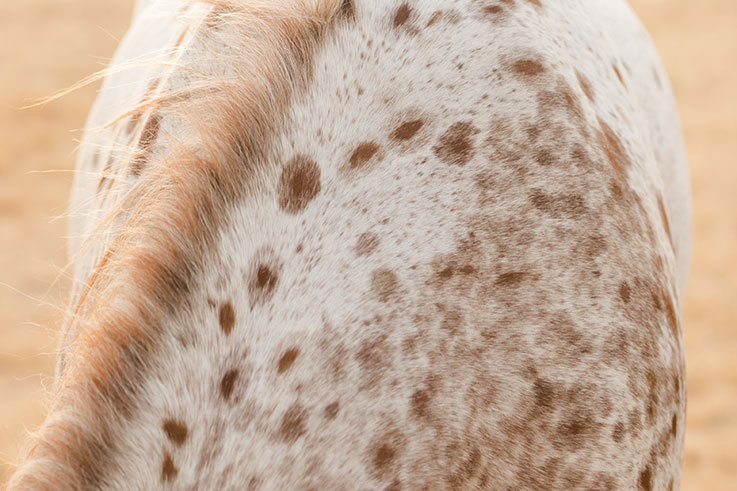
Appaloosas and ERU
A staggering 25% of horses diagnosed with ERU in North America are Appaloosas. This American breed is over eight times more likely to develop uveitis than all other horse breeds, and four times more likely to suffer blindness from ERU. They have a predilection to develop the disease bilaterally (in both eyes). In the 2020 paper, ‘Risk factors for equine recurrent uveitis in a population of Appaloosa horses,’ researchers found certain patterns to be more at risk than others within the Appaloosa family. “Fewspot” (practically white) had a 44% occurrence of ERU, followed by “Snowcap” (white blanket) with a 29% occurrence, then Leopard at 15% compared to other color types, such as those with blankets or solid patterns. The Veterinary Genetics Laboratory at the University of California, Davis, offers testing for the genetic variant that predisposes Appaloosa horses for congenital stationary night blindness.
Clinical Symptoms
- Milky, cloudy or bluish eye(s)
- Tearing
- Squinting
- Sensitivity to light
- Eye closed
- Redness or bloodshot sclera (white portion of the eye)
- Small pupil (compared to normal)
ERU can affect one or both eyes, and severity can differ between eyes. Horses with the disease will suffer from repeated episodes. While the frequency depends on the individual horse, ERU tends to escalate in severity with repeated flare-ups. Early diagnosis is key for a best prognosis. If you suspect ERU or see any of the clinical symptoms, contact your veterinarian to evaluate the horse immediately.
What Are the Causes of ERU?
The cause of ERU has been long debated with several possible viral, protozoal, bacterial, parasitic as well as noninfectious links investigated. Vitamin deficiencies (especially vitamins A, C and the B complex), physical trauma to the eye, the equine flu, abscesses (tooth, hoof) and deworming medication have also been suggested. What actually causes ERU is complex and likely multi-factorial but points to a genetic predisposition to autoimmune issues that correlate to external triggers. Likely a combination of genetics, environmental factors and underlying cause of the original episode are involved.
An infectious organism, the bacterium Leptospira spp, has been most studied as a causative factor for ERU. It is a common cause of ERU in the US and Europe, and exposure level has been found to be as high as 77.5% in some studies. There is a definitive increase in the incidence of vision loss and complications with ERU-affected horses and leptospirosis. Leptospirosis is a bacterial disease spread via a wildlife host through urine of infected animals, most commonly reported in humid, tropical climates. After leptospiral bacteria enter the bloodstream (leptospiremia phase) by way of the intestines they tend to settle in the kidneys, uterus, or the uveal tract of the eye. Ridding the body of infections in any of these areas is very difficult. This organism is a common cause of abortion, and of uveitis, and rarely kidney disease. However, it can persist in the kidneys without displaying symptoms, shedding the organism in urine (leptospiruria) for up to three months, which can cause perpetuation of leptospiral spread in herd situations. Fortunately, there is an equine-approved vaccine for leptospirosis, which has been shown to be effective at preventing leptospiremia and leptospiruria. For horses in high-risk areas, ask your veterinarian about the vaccine. In horses already dealing with leptospiral uveitis, it is best to focus on treatment and management of the flares. While this suggests increased exposure to Leptospira spp, you may consider vaccinating other horses on the property. Current evidence shows that the Leptospira organisms form an impenetrable biofilm layer that protects the bacteria from the antibiotics and from the immune system, making the organism both difficult to detect and to fight, leading to the recurrent inflammatory episodes.
Because horses positive for the LP gene tend to develop the insidious non-recurrent form of uveitis and are typically negative for Leptospira spp, some researchers feel it should be considered a separate disease. For this reason, the term “leopard coat pattern uveitis” has been suggested.
Treatments Available
Each ERU case is unique, and treatment varies depending on the individual horse. Early recognition is always important, but long-term prognosis is guarded for affected horses. The goal for every case is to preserve vision and maintain comfort. While some horses respond well to treatment, others can develop additional related problems, such as cataracts, glaucoma, eye shrinkage and retinal damage, which are each difficult to treat and all can potentially lead to blindness.
While there is no known cure for ERU, multiple medical treatments are available with the goal of eliminating or slowing the progression of inflammation in the eye, minimizing damage and controlling pain. Treatment may include a combination of topical corticosteroids (prednisolone, dexamethasone), oral (systemic) non-steroidal anti-inflammatory (NSAIDs, flunixin meglumine, phenylbutazone) medications, mydriatics (atropine) and immunosuppressive drugs. In severe cases, specific corticosteroids may need to be injected into the eye. Antibiotics may be prescribed if a bacterial infection is suspected. Active episodes typically require at least four weeks of treatment during which the horse may need to remain indoors, out of sunlight or wear a mask to protect the eyes from bright light. Unfortunately, none of these treatments necessarily prevent recurring episodes. During an active flare, treatment will need to resume.
Surgical Interventions
- In horses positive for Leptospira spp, a vitrectomy can be performed under general anesthesia, removing the majority of the core vitreous — the gel-like fluid that fills the eye — which is replaced with saline. The source of inflammation is removed by replacing the vitreous fluids containing Leptospira spp and its accompanying protective biofilm. Although this is a challenging surgery to perform, in Leptospira spp-positive cases, this procedure has a high rate of resolution. However, this procedure is less likely to be helpful in leopard coat pattern uveitis.
- The cyclosporine implant is a small, disc-shaped device that is surgically implanted into the sclera of the eye and slowly releases the medication, cyclosporine A, an immune-modulating T-cell inhibitor and anti-inflammatory drug. The implant can provide therapeutic dosages for up to three years. It often reduces the need for topical and oral medications and has been shown to be very beneficial in improving vision, controlling inflammation and minimizing episodes and recurrence.
- Finally, enucleation — the surgical removal of the eye(s) — is often necessary for ongoing painful eyes.
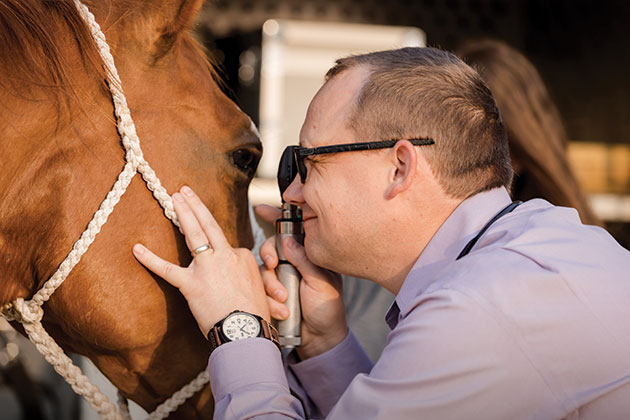
Vitamins A, C, the B-vitamin complex and omega-3 fatty acids are particularly important for healthy eye tissue and support normal vision.
Vitamins A, C, the B-vitamin complex and omega-3 fatty acids are particularly important for healthy eye tissue and support normal vision.
While vaccination with the leptospira vaccine may prevent the onset of disease in some cases, little else can be done to prevent ERU. Focusing on general health and a clean environment is always good husbandry. Schedule routine wellness visits with your veterinarian who will keep the horse current on vaccinations, deworming and dentistry, and will also perform a general physical exam evaluating the entirety of the horse, including the eyes. Provide a tidy, hazard-free environment to prevent eye trauma with special attention to fly control. Offer a balanced, forage-focused diet. Vitamins A, C, the B-vitamin complex and omega-3 fatty acids are particularly important for healthy eye tissue and support normal vision. Fresh grass provides beta-carotene, the precursor for vitamin A, vitamin C and omega-3 fats. Forage also supports a healthy hindgut where many of the B-vitamins are synthesized. Because of the stabilizing effect a healthy gut has on the immune system, digestive support through pre- and probiotics and L-glutamine would also support ocular health. Good nutrition is essential for immune health, which may be the best prevention we currently have for ERU.
